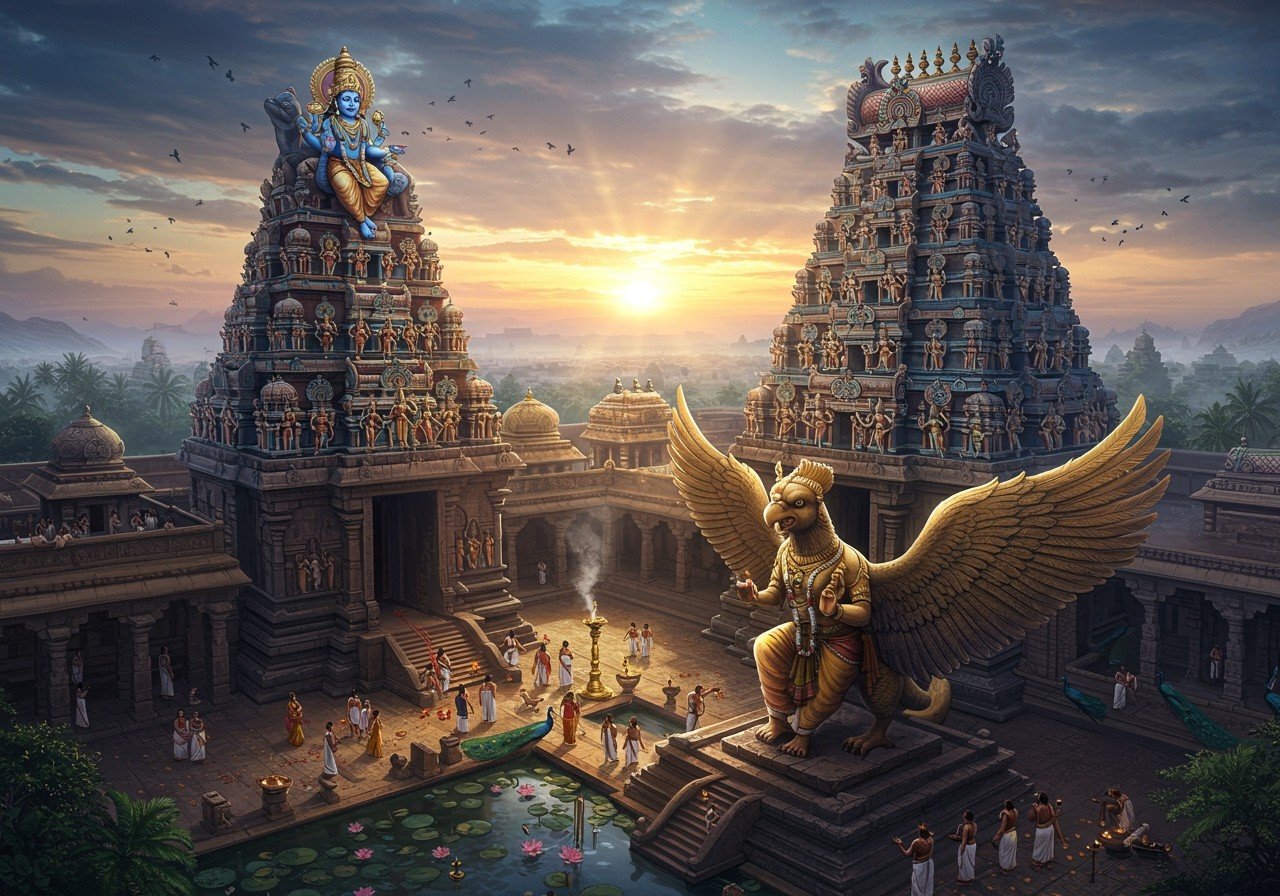
Vaishnava temples in South India are not just sacred sites; they are vibrant centers of tradition, culture, and living history. For centuries, these temples have nurtured and propagated the Vaishnava tradition, impacting art, architecture, and community life far beyond religious practices. Let’s embark on a journey to explore the rich tapestry of these divine abodes.
A Glimpse into History
The historical roots of Vaishnavism in South India are deep and intertwined with the region’s cultural fabric. Early patrons, including dynasties like the Pallavas, Cholas, and Pandyas, from the 7th to 10th centuries CE, elevated these temples to become cornerstones of religious life. The Alvars, revered poet-saints, used the power of devotional hymns to spread Vaishnavism among the common people, enriching Tamil literature. The Srivaishnava community, with scholars like Nathamuni (10th century CE) and Ramanuja (11th century), added to temple practices and philosophical discourse, ensuring the preservation of traditions. Temple inscriptions and recovered texts offer us glimpses into these rich traditions, reminding us of the challenges faced during colonial times and the revival these sacred sites experienced post-independence.
Sacred Destinations: Exploring Prominent Temples
Tamil Nadu, a land steeped in spirituality, houses some of the most remarkable Vaishnava temples. Each temple holds unique significance, narrating tales of devotion, art, and tradition.
- Sri Ranganathaswamy Temple, Srirangam: This colossal temple complex is an architectural marvel with intricate carvings, a testament to the devotion of generations. It’s not just a place of worship but a cultural hub where history comes alive, and devotees find solace in the presence of Lord Ranganatha.
- Parthasarathy Temple, Chennai: As one of the oldest temples dedicated to Lord Krishna as Parthasarathy, the charioteer of Arjuna, this temple emanates historical significance. Its architecture beautifully balances simplicity and grandeur, inviting visitors to experience its divine aura.
- Tirupati Venkateswara Temple: While geographically in Andhra Pradesh, this hilltop shrine’s influence transcends state boundaries. Millions journey annually to seek the blessings of Lord Venkateswara, revered for his grace. The temple’s traditional rituals offer deep spiritual fulfillment.
- Varadaraja Perumal Temple, Kanchipuram: Renowned for its grand festivals, this temple is a vibrant expression of faith and culture. Lord Varadaraja’s blessings are sought by all, and the festivals are joyous celebrations of devotion, unifying the community.
- Meenakshi Amman Temple, Madurai: Predominantly Shaivite, this temple showcases the harmonious blend of Shaivism and Vaishnavism in South Indian culture. Its breathtaking towers and sculptures captivate all who visit, symbolizing unity in diversity. Explore more about South Indian temples and pilgrimage itineraries.
- Thirukoshtiyur Temple: Deeply connected to Ramanuja, this temple is a beacon of Vaishnava philosophy. It was here that Ramanuja shared the sacred Ashtakshara mantra, emphasizing spiritual equality. Discover Lakshmi Narasimha temples near you.
The Melodious Resonance of Divya Prabandham
The Divya Prabandham, a collection of 4,000 Tamil verses by the Alvars, holds immense significance within Vaishnava temples, enriching worship and spiritual life.
- Woven into Daily Rituals: The hymns are an integral part of daily worship and festivals, drawing devotees closer to the divine. Their recitation creates an immersive spiritual experience.
- Nathamuni’s Legacy: Nathamuni’s invaluable contribution lies in recovering and preserving these hymns. His efforts ensured that these sacred verses continue to resonate through time, enriching our spiritual heritage.
- Araiyar Sevai: Dance and Music: This unique form of worship brings the Divya Prabandham to life. Through expressive dance and music, the hymns are not just sung but embodied, becoming a dynamic offering of devotion.
- Cultural Cornerstone: Beyond their devotional significance, these hymns have deeply influenced Tamil language and literature. They are cultural treasures, inspiring generations with their poetic beauty and spiritual depth.
Architectural Splendor: A Dravidian Legacy
South Indian temples showcase the magnificence of Dravidian architecture, with towering gopurams and intricate carvings that narrate stories in stone.
- Strength in Granite: The use of local granite in temple construction not only ensures longevity but also symbolizes harmony with nature. These temples stand as testaments to the ingenuity of ancient builders.
- Mandapams and Sanctum Sanctorum: The pillared halls, or mandapams, serve as spaces for community gatherings and rituals, fostering a sense of belonging. The sanctum sanctorum, the heart of the temple, is where the divine presence is most palpable.
- Connecting with the Cosmos: Temple layouts often reflect cosmic elements, aligning earthly worship with celestial order. This symbolic connection elevates the spiritual meaning of the sacred space. Learn more about South Indian traditions.
- Royal Influences: Each ruling dynasty has left its unique imprint on temple architecture. These diverse influences have shaped the structures, art, and iconography, adding layers of historical and artistic significance.
Cultural Impact: Beyond the Temple Walls
Vaishnava temples are not merely religious structures; they are cornerstones of South Indian culture.
- Patrons of Art and Music: These temples have served as nurturing grounds for various art forms, including music, dance, and sculpture. Festivals like Brahmotsavam showcase the rich cultural heritage that thrives under temple patronage.
- Social Responsibility: Many temple trusts are actively involved in social and charitable initiatives, contributing to education, healthcare, and community upliftment. Their efforts promote well-being beyond spiritual pursuits. Explore more about the cultural impact of South Indian temples.
- Temple Tourism: Tourism plays a vital role in both cultural preservation and economic growth. Visitors from around the world contribute to the sustenance of local traditions. Their presence helps keep these ancient practices alive.
- Digital Bridges: In the digital age, online platforms extend the reach of temple rituals to devotees far and wide. This increased accessibility ensures that ancient traditions remain vibrant and relevant to a global audience.
Poojn.in: Bringing Temple Traditions Home
Poojn.in helps you bring the sanctity of Vaishnava temple worship into your home with authentic, temple-grade puja items. We offer a curated selection of essential supplies used in South Indian Vaishnava temples:
- Pure brass and copper lamps (deepams) for aarti ceremonies like this Adiyogi Marble Dust Murti.
- Traditional bell metal plates for naivedyam offerings.
- Authentic tulsi mala and kanthi mala crafted from sacred tulsi wood like this Vaijanti Mala.
- Pure cotton vastrams and angavastrams in traditional temple styles.
- Pancha loha (five metals) idols of revered Vaishnava deities such as this Dakshina Maa Kali Murti or this Lord Shiva Marble Dust Murti.
- Sacred threads and mouli in temple-approved colors.
- Pure camphor and sambrani for temple-style dhoop.
Standing Shiva Pure Marble Dust Murti and Ganga Shiva Pure Marble Dust Murti are also available.
All items come with detailed usage instructions in multiple languages. Our expert team can guide you in selecting the right items for your specific temple traditions.
To order your temple puja items:
Visit: www.poojn.in
Call: 03369029784
WhatsApp: 9476142738
We offer pan-India delivery and special discounts on bulk orders for temple committees during festival seasons. All products are verified for authenticity and meet temple-grade quality standards.
Note: Prices and availability of items may vary. Please check our website for current details.
Bridging Tradition and Modernity
The Vaishnava temples of South India are timeless guardians of faith, culture, and history. More than just structures of stone, they are living institutions that inspire and connect us to our roots. Walking through their ancient corridors, one can almost hear the whispers of devotion echoing through the centuries. These temples remind us of the profound beauty of tradition and the richness of our heritage.
Embracing both tradition and modernity, these temples bridge the past and the future. Through digital innovations, they invite a global audience to participate in their sacred rituals, ensuring that the spiritual wisdom and cultural treasures they hold remain vibrant and accessible to all. As we cherish these sacred spaces, we find solace and strength, knowing that the legacy of Vaishnava temples will continue to illuminate our path with divine grace and cultural richness.
FAQs
What are some well-known Vaishnava temples in Tamil Nadu? Tamil Nadu boasts numerous revered Vaishnava temples, including the magnificent Ranganathaswamy Temple in Srirangam, the historic Parthasarathy Temple in Chennai, and the vibrant Varadharaja Perumal Temple in Kanchipuram, each offering a unique spiritual experience.
How does the Divya Prabandham enrich temple worship? The Divya Prabandham, a collection of 4,000 Tamil hymns composed by the Alvars, plays a central role in temple worship. These hymns, sung during rituals and festivals, deepen the spiritual atmosphere and connect devotees with the divine through the power of devotional poetry.
What distinguishes the architecture of South Indian Vaishnava temples? South Indian Vaishnava temples are characterized by their towering gopurams (gateway towers), intricate carvings, and spacious courtyards, showcasing the Dravidian architectural style. These majestic structures feature pyramid-shaped towers and elaborate stone sculptures that depict deities and mythological narratives, creating a visually stunning and spiritually rich environment.
Why are Vaishnava temples integral to South Indian culture? Vaishnava temples serve as vital hubs for religious, social, and cultural activities, playing a central role in South Indian culture. They are not only places of worship but also venues for festivals, music and dance performances, and community gatherings, preserving traditional arts and values while fostering a sense of belonging.
Are there festivals unique to South Indian Vaishnava temples? Yes, many festivals are specific to these temples, such as Vaikunta Ekadasi, celebrated with great fervor in Tamil Nadu. During these festivals, the temples come alive with special rituals, processions, and cultural events, creating a vibrant atmosphere of devotion and celebration.
What is the significance of the temple rituals and ceremonies? Temple rituals and ceremonies are designed to honor the deities and create a sacred space for devotees. They involve daily pujas, abhishekams (ritual bathing of the deity), and seasonal events that mark the temple calendar, offering devotees opportunities to connect with the divine and experience spiritual renewal.
How do Vaishnava temples contribute to the local community? Vaishnava temples contribute significantly to the local economy by attracting pilgrims and tourists, supporting local businesses, and providing employment opportunities. They also play a vital role in community life by offering educational programs, charitable services, and social support, fostering a sense of unity and well-being.


